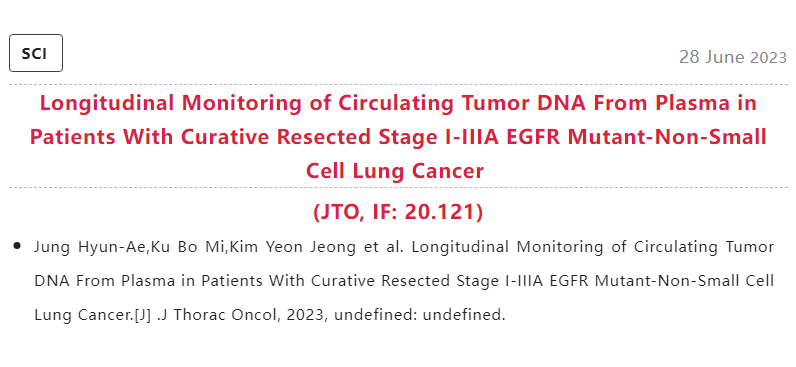对EGFR突变非小细胞肺癌I-IIIA期手术治愈患者血浆循环肿瘤DNA的纵向监测

INTRODUCTION 介绍
For patients with early-stage epidermal growth factor receptor mutation positive (EGFR-M+) non-small cell lung cancer (NSCLC), curative surgery followed by adjuvant chemotherapy is considered the standard of care. This study assessed the feasibility and efficacy of longitudinal monitoring of circulating tumor DNA (ctDNA) as a valuable biomarker for early detection of minimal residual disease (MRD) and provides identification of the group at high-risk for recurrence in resected stage I-IIIA EGFR-M+ NSCLC.
对于早期表皮生长因子受体突变阳性(EGFR-M+)非小细胞肺癌(NSCLC)患者,根治性手术后辅助化疗被认为是标准治疗方法。本研究评估了循环肿瘤DNA(ctDNA)纵向监测作为早期微小残留病灶(MRD)的有价值生物标志物的可行性和疗效,并确定了EGFR-M+ NSCLC手术切除的I-IIIA期患者中具有高复发风险的人群。
METHODS 方法
Between August 2015 and October 2017, a total of 278 patients with curative resected, stage I-IIIA (AJCC 7 version) common EGFR-M+ NSCLC were analyzed. Radiological follow-up was accompanied with longitudinal monitoring of ctDNA using a droplet digital PCR from baseline (pre-operative), 4 weeks after curative surgery, and follow-up per protocol until 5 years. The primary outcomes were disease-free survival (DFS) according to the status of ctDNA positivity at landmark points and the sensitivity of longitudinal monitoring of ctDNA.
分析了2015年8月至2017年10月间共278名接受根治性手术切除的I-IIIA期(AJCC 7版本)EGFR-M+ NSCLC患者。影像学随访结合基线(术前)、手术后4周和随访直至5年期间使用液滴数字PCR纵向监测ctDNA。主要终点为根据里程碑点上ctDNA阳性状态的无病生存(DFS)以及ctDNA纵向监测的敏感性。
RESULTS 结果
Among 278 patients, pre-operative baseline ctDNA was detected in 67 (24%) patients: 23% (stage IA), 18% (IB), 18% (IIA), 50% (IIB), and 42% (IIIA) (p = 0.06). 76% (51 of 67) of patients with baseline ctDNA showed clearance at 4 weeks after surgery (post-operative). Patients were classified into three groups; Group A, baseline ctDNA negative (n = 211) vs Group B, baseline ctDNA positive but post-operative MRD negative (n = 51) vs Group C, baseline ctDNA positive and post-operative MRD positive (n = 16). The 3-year DFS rate was significantly different among the three groups (84% for Group A, 78% for Group B, and 50% for Group C, p = 0.02). After adjusting for clinicopathologic variables, ctDNA still remains an independent risk factor for DFS along with stage (p < 0.001) and micropapillary subtype (p = 0.02). With longitudinal monitoring of ctDNA, MRD was detected prior to radiological recurrence in 69% of patients with exon 19 del and in 20% with L858R mutation.
在278名患者中,术前基线ctDNA检测到67例(24%)患者:23%(IA期)、18%(IB期)、18%(IIA期)、50%(IIB期)和42%(IIIA期)(p = 0.06)。在手术后4周,67名患者中76%(51名)的基线ctDNA消失(术后MRD阴性)。患者分为三组:A组,基线ctDNA阴性(n = 211);B组,基线ctDNA阳性但术后MRD阴性(n = 51);C组,基线ctDNA阳性且术后MRD阳性(n = 16)。三组患者的3年DFS率显著不同(A组为84%,B组为78%,C组为50%,p = 0.02)。在调整临床病理变量后,ctDNA与分期(p < 0.001)和微乳头亚型(p = 0.02)一起仍然是DFS的独立危险因素。通过ctDNA的纵向监测,在19号外显子缺失型突变中有69%的患者在影像学复发之前检测到MRD,而在L858R突变中有20%的患者检测到MRD。
CONCLUSIONS 结论
These results suggest that patients with baseline ctDNA-positive or MRD-positive status were associated with poor DFS in curative resected stage I-IIIA EGFR-M+ NSCLC, and that longitudinal monitoring of ctDNA, a non-invasive method, might be useful to detect early recurrence prior to radiological recurrence.
这些结果表明,在根治性手术切除的I-IIIA期EGFR-M+ NSCLC患者中,基线ctDNA阳性或MRD阳性状态与较差的DFS相关,并且ctDNA的纵向监测作为一种非侵入性方法,可能有助于在放射学复发之前检测到早期复发。
本文章转载于:SCI天天读
原文链接:https://mp.weixin.qq.com/s/nDkTVJLLmDPGPJz0dJqxow
